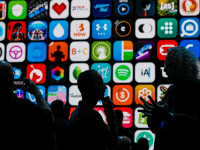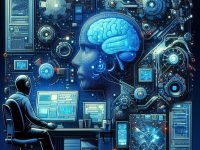20 Types of Technology in the World and Their Explanations – Technology is evolving at an astonishing pace, changing the way we live, work, and communicate. From artificial intelligence to virtual reality, technology has revolutionized every aspect of our lives. In this article, we’ll explore 20 different types of technology and their explanations, so you can stay up-to-date with the latest advancements in the world of tech.

20 Types of Technology in the World
There are so many different types of technology out there, each one with its own unique purpose and potential to change the world.
From the latest smartphones and computers to cutting-edge robotics and artificial intelligence, we truly live in an era of unprecedented technological innovation. It’s amazing to see how far we’ve come and how much we’ve accomplished in such a short amount of time.
And it’s not just about the big stuff, either. Even seemingly simple technologies like the humble pencil or the basic calculator have had a massive impact on our lives and our society as a whole.
So whether it’s advanced medical equipment, renewable energy technologies, or even just a basic kitchen appliance, there’s no denying the incredible power and potential of technology to transform our world for the better.
Artificial Intelligence (AI)
AI is the simulation of human intelligence in machines that are programmed to think and act like humans. AI is used in a wide range of applications, including image and speech recognition, predictive analytics, and robotics.
Internet of Things (IoT)
The Internet of Things is the network of physical devices, vehicles, home appliances, and other items embedded with electronics, software, sensors, and connectivity that enables them to connect, collect and exchange data. This technology is used in various applications like smart homes, healthcare, and transportation.
Read About IoT Level 2 in the Architecture: Bridging the Gap between Devices and Cloud.
Blockchain Technology
Blockchain technology is a decentralized and distributed ledger that is used to record transactions across many computers so that the record cannot be altered retroactively without the alteration of all subsequent blocks and the collusion of the network. The technology is used in the financial industry, supply chain management, and voting systems.
Cloud Computing
Cloud computing is the delivery of computing services, including servers, storage, databases, networking, software, analytics, and intelligence, over the internet. This technology allows businesses and individuals to access their data and applications from anywhere in the world.
Augmented Reality (AR)
AR is the integration of digital information with the user’s environment in real-time. This technology is used in various applications, including gaming, education, and retail.
Virtual Reality (VR)
VR is a computer-generated simulation of a three-dimensional environment that can be interacted with in a seemingly real or physical way by a person using special electronic equipment. This technology is used in gaming, training, and education.
Robotics
Robotics is the branch of technology that deals with the design, construction, operation, and application of robots. It’s used in various applications, including manufacturing, healthcare, and space exploration.
Biotechnology
Biotechnology is the application of technology to the study of living organisms, with the goal of improving human health and the environment. It’s used in various applications, including agriculture, medicine, and environmental conservation.
5G Technology
5G technology is the fifth generation of cellular mobile communications. This technology provides faster data speeds, increased network capacity, and lower latency, allowing for the development of new applications like remote surgery, autonomous driving, and virtual and augmented reality.
Nanotechnology
Nanotechnology is the manipulation of matter on an atomic, molecular, and supramolecular scale. This technology is used in various applications, including medicine, energy, and electronics.
Quantum Computing
Quantum computing is the use of quantum-mechanical phenomena, such as superposition and entanglement, to perform computation. This technology has the potential to solve problems that are currently unsolvable with classical computers, such as encryption and optimization.
Autonomous Vehicles
Autonomous vehicles are vehicles that are capable of sensing their environment and navigating without human input. This technology is used in various applications, including transportation, logistics, and delivery.
Renewable Energy
Renewable energy is energy that is collected from renewable resources, which are naturally replenished on a human timescale. This technology is used in various applications, including power generation, transportation, and heating.
Cybersecurity
Cybersecurity is the practice of protecting our digital devices, networks, and data from unauthorized access, theft, and damage. It’s becoming increasingly important in today’s world, as more and more of our lives are conducted online.
3D Printing
3D printing is the process of creating a three-dimensional object by building it layer by layer using a computer-aided design model. This technology is used in various applications, including manufacturing, healthcare, and architecture.
Wearable Technology
Wearable technology is electronic devices that can be worn on the body, either as an accessory or as part of clothing. This technology is used in various applications, including fitness tracking, healthcare, and communication.
Drones
Drones are unmanned aerial vehicles that are remotely controlled or operate autonomously. This technology is used in various applications, including photography and videography, delivery, and agriculture.
Biometrics
Biometrics is the measurement and analysis of unique physical or behavioral characteristics of an individual, such as fingerprints, iris patterns, and voice recognition. This technology is used in various applications, including security and access control.
Smart Cities
Smart cities are cities that use technology to improve the quality of life for their citizens. This technology is used in various applications, including transportation, energy, and public safety.
Space Technology
Space technology is the application of science and engineering to the exploration and use of space. This technology is used in various applications, including space exploration, satellite communication, and weather forecasting.
As technology continues to advance at a rapid pace, it’s important to stay up-to-date with the latest trends and developments. By understanding these 20 types of technology and their applications, you can gain a deeper appreciation for the role that technology plays in our lives and how it will continue to shape our future.
In conclusion, technology has come a long way and will continue to evolve in the coming years. We must embrace and harness its power to create a better world for ourselves and future generations. With the rapid pace of change, it’s essential that we keep learning and adapting to new technological advancements.
FAQs:
- What is the most advanced technology in the world?
The most advanced technology in the world is constantly evolving, with new breakthroughs and innovations emerging every day. From quantum computing to gene editing, the possibilities are endless. - How is technology affecting our daily lives?
Technology has become an integral part of our daily lives, impacting everything from how we communicate to how we work and play. - What are the benefits of wearable technology?
Wearable technology has the potential to revolutionize the way we track and monitor our health, improve our performance, and enhance our overall well-being. From smartwatches to fitness trackers, these devices can provide valuable insights into our physical and mental health. - What are the potential risks of autonomous vehicles?
While autonomous vehicles have the potential to improve road safety and reduce traffic congestion, they also come with potential risks such as hacking, malfunctioning software, and the loss of jobs for drivers. - How can we ensure the ethical use of biotechnology?
As biotechnology advances, it’s important to ensure that it used in an ethical and responsible manner. This requires strict regulations and oversight, as well as a commitment to transparency and open dialogue between scientists, policymakers, and the public. - How has technology impacted the job market?
Technology has significantly impacted the job market, with many traditional jobs being replaced by automation and artificial intelligence. However, it has also created new job opportunities in emerging fields such as cybersecurity, data science, and digital marketing. - What is the future of technology?
The future of technology is exciting and unpredictable. With advancements in fields such as artificial intelligence, biotechnology, and space exploration, the possibilities are endless.




